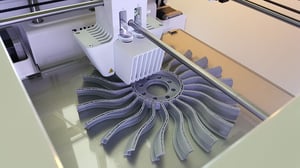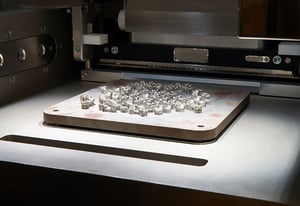 As technology is changing and advancing, there are an array of new manufacturing processes that can elevate operations. Additive manufacturing is completely changing these traditional practices while also saving time and money in the process. Read on to find out if additive manufacturing is right for your operation.
As technology is changing and advancing, there are an array of new manufacturing processes that can elevate operations. Additive manufacturing is completely changing these traditional practices while also saving time and money in the process. Read on to find out if additive manufacturing is right for your operation.
What is Additive Manufacturing?
Additive manufacturing (AM), also referred to as 3D printing, is a process that takes a digital design and creates a tangible object. CAD (computer-aided design) software is used to create a given design where that digital file is uploaded into an additive machine. This machine is then able to produce an object layer by layer with the use of heat lasers or electron beams. Learn more about additive manufacturing here.
 Advantages to Additive Manufacturing
Advantages to Additive Manufacturing
Many industries are working with additive machines due to these machine’s advantages with customization, durability, and lightness in comparison to traditional parts. One of the most important advantages around additive manufacturing is its allowance for mass customization. A greater range of possible designs can be created within the machine. Complex structures can easily be created due to the design freedom that is offered. Shapes that have a hollow center or other peculiar features can now be assembled in a continuous unit.
Another benefit in this process is that stronger parts are now being produced. An object can be formed from one whole entity rather than an assortment of various pieces. This eliminates “stress points” that non-additive parts contain when they aren’t completed in an entire singular form. Alongside this, these new parts are now lighter in comparison to the usual components.
Reliability and convenience are a considerable upside for additive manufacturing. This method allows for the reduction of the lengthy, and traditional manufacturing process . With additive manufacturing, a specific part can be produced instantaneously. Factories rely on these machines to access parts they need quickly, in order to keep the factory running without fail. Instead of waiting to receive a shipment, they can tailor the extract part on site in a fraction of the time. Products are created in days, as opposed to months, while simultaneously saving on the traditional cost of the conventional manufacturing processes. This has also decreased the initial risk factor for manufacturing prototypes. Product prototypes can now receive feedback quickly since their production time span has been cut down dramatically.
 Disadvantages to Additive Manufacturing
Disadvantages to Additive Manufacturing
While many advancements are happening in additive manufacturing, it still has its disadvantages. One of the disadvantages is the limitations when it comes to the size of the object being produced. The size of the objects is limited to the dimensions of the printer that it’s enclosed inside. This doesn’t only pose a hindrance for the potential to create larger objects but also limits the number of small parts that can be produced at once.
Speed, in the sense of in-house production, is much faster than outsourcing and waiting for a shipment to arrive. However, speed within the machine itself is rather slow when manufacturing the object itself. Going layer by layer prevents the machine from working at a fast pace and accounts for a slower production speed.
While investing in additive manufacturing, the upfront cost of the equipment is expensive. While the payout is cost efficient for manufacturers, the initial investment isn’t. The machine itself can cost anywhere from 300,000 to over a million dollars for the machinery. The materials also carry a burden of cost with them as well.
 Industries Additive Manufacturing
Industries Additive Manufacturing
Additive manufacturing can be found in many industries including automotive, medical, and aerospace. In the medical industry, this technology can be used to create patient-specific surgical guides and products. Here the use of additive manufacturing is ideal since every patient is unique, and this machine can custom tailor to those exact patient specifications. This also allows the formation of prosthetics to be manufactured at a much more cost-effective rate than previously. Read more about additive manufacturing in the health care industry here. Another industry that commonly uses additive manufacturing is the automotive industry. From the start, Ford Motor Company purchased the third 3D printer that was ever made in 1998 and now houses over 90 of these printers. Additive manufacturing allows for Increased production and can develop 3D prototypes inexpensively and quickly. This is a fundamental and effective use of this technology.
A significant proponent for additive manufacturing is the aerospace industry. This technology is relied upon for its lightweight durability, capability to produce complex parts, and strength. This technology is changing the manufacturing process for aircrafts and comprises 19% of the additive manufacturing market (Wohlers Report 2018). Aircrafts contain millions of individual parts that are produced by hundreds of companies. This results in timely and costly delays centered around waiting for a part. Additive manufacturing has aided this issue by providing a new manufacturing solution.
Conclusion
Additive manufacturing is still an emerging technology and isn’t without the standard manufacturing kinks. While these machines may be costly and offer limitations, they combat those issues with a highly specialized process that can’t be found anywhere else. This is advancing the way the manufacturing process works by bringing efficiency and adaptability to many different industries.
To learn more about Radwell International

